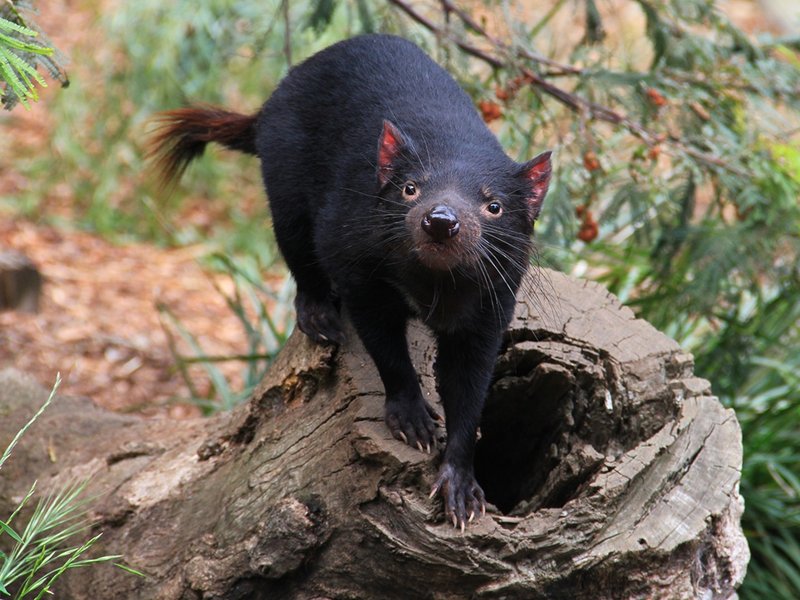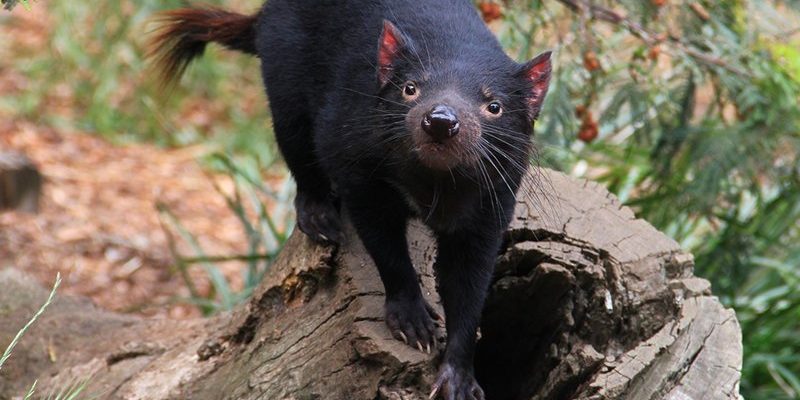
Let’s take a step back in time to understand how the Tasmanian devil came to be. These carnivorous marsupials originally thrived in Australia before they became isolated on the island of Tasmania. Think of it like a soap opera: as Australia changed, the devils had to adapt to their new reality. Their journey is a fascinating blend of evolution, environmental changes, and survival against the odds. Grab your coffee; we’re about to dive in!
What is the Tasmanian Devil?
The Tasmanian devil (Sarcophilus harrisii) is a small carnivorous marsupial native to Tasmania. If you’ve never seen one, picture a compact little critter with a stocky body, short legs, and a notoriously powerful jaw. They’re often around the size of a small dog, but don’t let their size fool you—they’re tough cookies! With their dark fur and distinctive white markings on their face and chest, they look like they’ve just come from an intense punk rock concert.
These devils are nocturnal, which means they’re active at night, scavenging for food. They have a keen sense of smell and aren’t picky eaters—they’ll munch on anything from carrion to small mammals. This scavenging lifestyle is essential for their role in the ecosystem, helping to keep the environment clean by consuming dead animals.
But here’s the kicker: their reputation as fierce creatures is partly due to their loud and eerie screams. It’s like having a rock concert in the woods when they’re around! These sounds serve a purpose, too—helping to establish territory and attract mates.
Origins of the Tasmanian Devil
The story of the Tasmanian devil begins millions of years ago, back in the age of the dinosaurs. Believe it or not, its ancestors were once part of a larger group of marsupials that roamed Australia and New Guinea. Scientists think the Tasmanian devil’s lineage can be traced back to the *Dasyuridae* family, which includes all sorts of small to medium-sized carnivorous marsupials.
Around 12,000 years ago, the Tasmanian devil was widespread across mainland Australia. However, as the climate changed and human activity increased, their habitat started to shrink. You might think of it like a game of musical chairs—there just wasn’t enough room for everyone, and the devils were left with nowhere to go. They eventually retreated to Tasmania, which became their refuge, but also isolated them from their mainland relatives.
Over time, these creatures adapted to their island home. Their diet, behavior, and even social structures evolved to fit the unique environment of Tasmania. The devils developed a knack for scavenging, which helped them thrive despite their limited resources.
The Role of Isolation in Evolution
Isolation can be a double-edged sword, especially for a species like the Tasmanian devil. On one hand, being cut off from mainland Australia allowed them to adapt and thrive in Tasmania’s unique environment. On the other hand, this isolation made them vulnerable to new threats, particularly when humans arrived on the scene.
The Tasmanian devil is a prime example of how evolution works in response to environmental pressures. Without competition from other large predators, these devils filled an ecological niche, leading to their current behavior and dietary habits. They became the top scavengers in their habitat, efficiently breaking down carrion and recycling nutrients back into the ecosystem.
However, isolation also meant that the devils had a limited gene pool. As their population dwindled due to habitat loss and introduced diseases, such as the notorious devil facial tumor disease (DFTD), their genetic diversity decreased. This lack of diversity can lead to inbreeding, making it harder for the population to adapt to changing conditions.
Understanding the Devil Facial Tumor Disease (DFTD)
One of the biggest challenges facing the Tasmanian devil today is the devil facial tumor disease (DFTD). This transmissible cancer has decimated populations since it was first observed in the mid-1990s. It’s a heartbreaking scenario; the disease spreads through direct contact, often during fights or mating.
Here’s the thing: DFTD isn’t just a health crisis for the devils; it’s an evolutionary one, too. The rapid spread of this disease has led to significant declines in devil populations. Scientists are racing against time to understand the disease and find ways to help the surviving animals. Captive breeding programs and disease monitoring efforts are underway, but the clock is ticking.
It’s a tough spot for the devils. The pressures of disease, habitat loss, and climate change are forcing them to adapt quickly. The question is whether they can evolve at a fast enough pace to survive these modern-day challenges.
The Importance of Conservation Efforts
Given the plight of the Tasmanian devil, conservation efforts have become crucial. Organizations and researchers are working tirelessly to raise awareness and implement strategies to save this iconic species. It’s like a team of superheroes, all dedicated to ensuring the future of the devil.
One of the major initiatives involves creating safe zones where the devils can thrive without the threat of DFTD. These areas are often monitored closely, allowing scientists to observe their behaviors and genetics over time. Captive breeding programs are also important. By carefully pairing healthy individuals, researchers hope to increase genetic diversity and resilience in the population.
Public education plays a pivotal role in conservation efforts. The more people know about the Tasmanian devil’s struggles, the more support these initiatives receive. It’s all about rallying together as a community to protect these fascinating creatures and their habitat.
Future Outlook for the Tasmanian Devil
So, what does the future hold for the Tasmanian devil? It’s a bit of a mixed bag. On one hand, the ongoing efforts in conservation and research give us hope. Scientists are making strides in understanding DFTD and how to combat it. Plus, the development of disease-resistant devil populations in captive breeding programs has sparked optimism.
On the other hand, the challenges are significant. Climate change, habitat destruction, and new diseases pose continuous threats. For the Tasmanian devil to thrive, it’s essential for us to keep supporting conservation initiatives and stay informed about their status.
The Tasmanian devil’s evolutionary history is a rich tapestry woven with survival, adaptation, and resilience. While their future might seem uncertain, there’s still hope. By understanding their story and supporting conservation efforts, we can help ensure that these unique creatures continue to roam the wilds of Tasmania for generations to come.
In the end, the Tasmanian devil is not just a fascinating animal; it’s a symbol of how interconnected our ecosystems are and the importance of preserving them. Let’s keep cheering for these little fighters as they navigate the challenges of the modern world!

